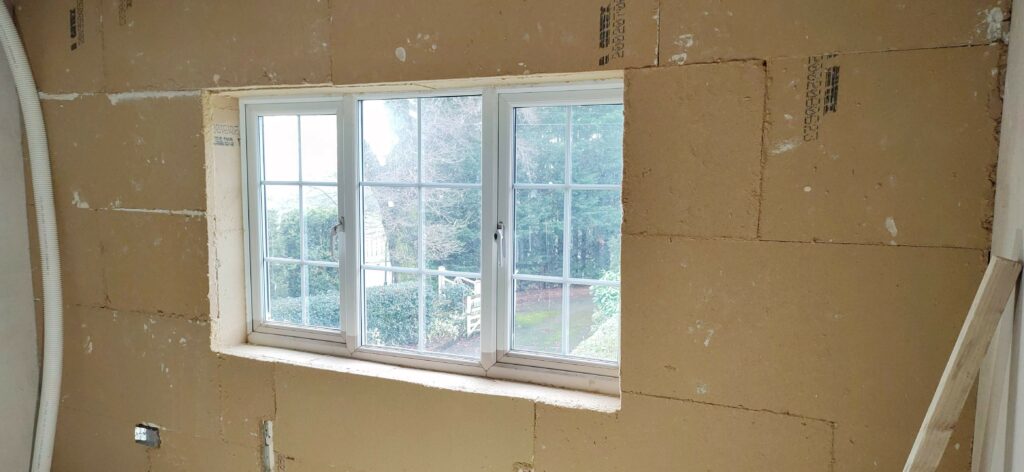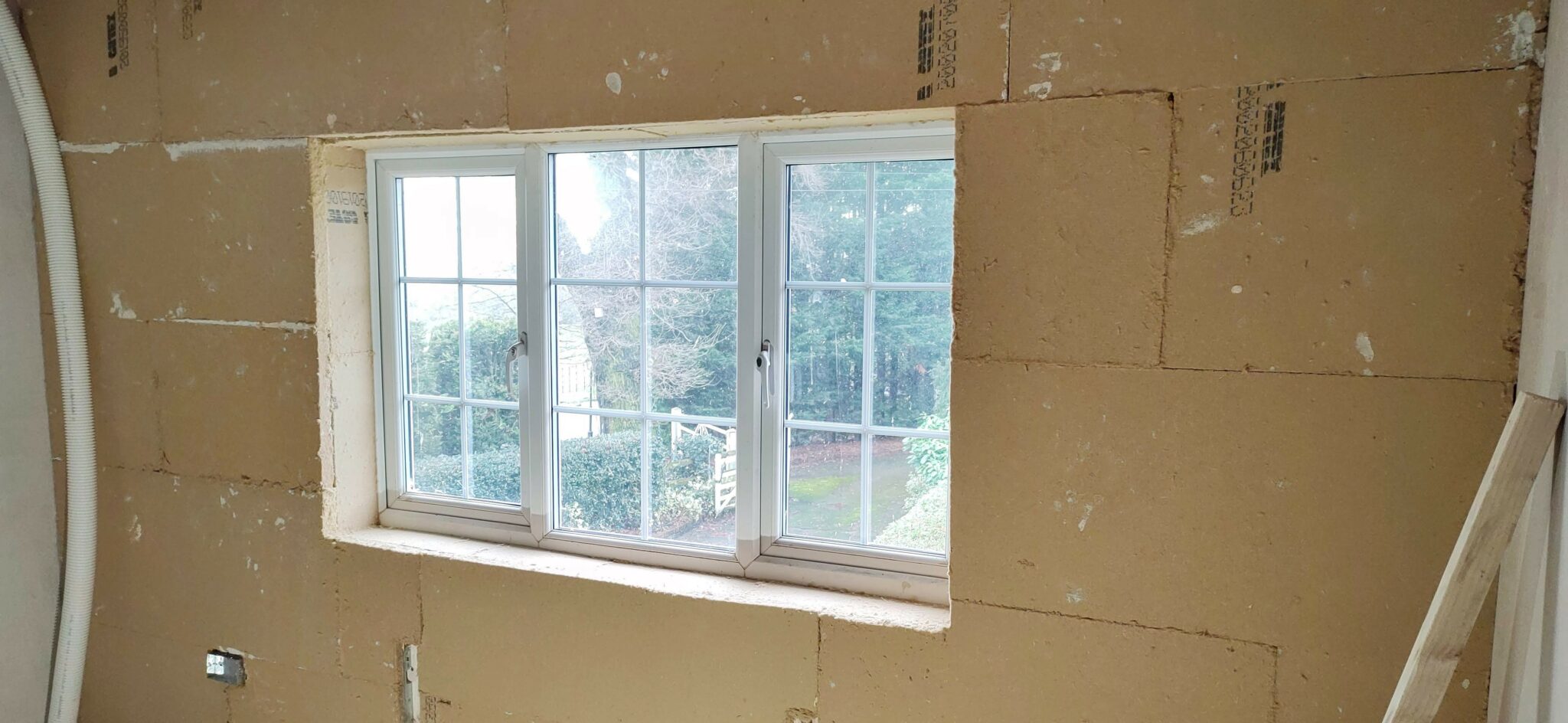The number assigned to a building fabric element (eg, a window) that represents its thermal resistance is called its U-value. A U-value tells us how quickly or slowly it takes for heat to pass through it. Fabrics with lower U-values are better insulators than those with higher U-values.
Part L of the UK Building Regulations (Conservation of Fuel and Power outlines all of the legal requirements for insulating modern homes.
In newly-built homes in 2016 the construction industry has to install windows which have a maximum Uw-value of 1.4W/m2K (Watts per metre-squared Kelvins) or lower, or a Window Energy Rating of ‘B’, which is pretty much the same thing.
Notice the little ‘w’ after the U in U-value.
It’s important because it represents the combined U-values of the frame, glazing and spacer parts within the window, ie, the FRAME (Uf-value), the GLAZING (Ug-value) and the SPACER (psi-value). The spacer is the material between the glazing panes. By calculating all of those fabrics together based on their respective area and thickness you have the Uw-value.
The Uw-value is what you should request from your window manufacturer (ie, with the “w”).
Also, consider that this Uw value is an uninstalled value. A triple or double-glazed window is only as good as its installation. Poor installation can reduce an expensive window’s Uw-value, as heat is lost through the frame at points where either the installation doesn’t meet it, or there are thermal bridges or cold air gaps. Poor window installation can also cause condensation along window frames.
Triple-glazed windows, installed correctly, should have a Uw-value of 0.85W/m2K or lower.
How do you calculate how much money your triple-glazed windows will save from the U-value?
Let’s say you have a double-glazed window in your living room that is 2 metres wide and 2 metres high. It has a Uw-value of 1.5Wm2K and you are considering replacing it with a triple-glazed window that has a Uw-value of 0.7Wm2K.
To calculate how much money you will save on heating lost through the double-glazed window you follow the steps below.
- Work out the difference between the two window U-values (1.5 – 0.7 = 0.8Wm2K)
- Multiply that number by the window area (0.8 x (2 x 2) = 3.2)
- Work out temperature difference inside and outside your home (21DegC – 4DegC = 17)
- Multiply the temperature difference by the U-value area (3.2 x 17 = 54.4)
- Divide that number by 1000 to convert it into kilowatts per hour (54.4 / 1000 = 0.0544kWh)
- Multiply that by 24hrs in a day and 365 days in a year to get your annual kWh (0.0544 x x 24 x 365 = 476.54kWh)
- Multiply that figure by the cost of a kWh of gas (476.54 x 3.8p =£18.11 per year, of heat lost through that window)
This is a slightly crude calculation as there are always other factors involved, but to replace that single double-glazed window in your living room with a triple-glazed version will save you perhaps £9 per year in heating bills, assuming you heat up your home for half the year in the cold months.
In short, there’s only a small payback in triple-glazed windows compared to good-quality double-glazed windows.
And it doesn’t compare to the payback available through solar panels, Mechanical Ventilation with Heat Recovery (MVHR) or biomass heating systems, unless you’re looking at a whole house PassivHaus approach, in which case you can get your annual heating bills down to £40 per year, and that feels very good.
But triple-glazed windows also offer increased comfort, more security, better sound-proofing and prevent condensation forming. They also allow more of the room to be used right up to the window, and allow for a smaller heating system – which can save on capital heating costs.
Why choose triple-glazing?
Because it’s much more comfortable to live in a triple-glazed home. Stand by a single-glazed window when it’s snowing outside and the air temperature will be about 1DegC – horribly uncomfortable and dripping with condensation (and black mould).
Stand next to a triple-glazed window, with a centre-pane U-value of around 0.65Wm2K and the temperature will be about 18DegC – lovely and warm and no condensation. We humans sense cold radiation very easily, and sitting near a window when it’s cold outside makes us shiver.
Also, it’s impossible for condensation to form on a surface with a temperature of 18DegC, so you won’t be troubled by excessive moisture, which can cause black mould and subsequent health problems. Another way to deal with mould and condensation is to improve ventilation explained here.
Triple-glazed windows are expensive, but if you’re considering replacing your current windows it’s worthwhile to pay a little more for the triple-glazed versions because you’ll be more comfortable and healthier with triple-glazed windows in your walls.
An alternative to upgrading your windows if they’re in a good condition is to focus on improving the airtightness of the building fabric and combining it with an MVHR system, which offers fresh, filtered and passively-warmed air to the home.

An MVHR system also means that you can remove or block up the window trickle vents, which are a source of cold in winter.
If you’d like more details on making your home more airtight and improving ventilation, please feel to contact me via the Contact Page at the top of the page.

Let’s say you have a double-glazed window in your living room that is 2 metres wide and 2 metres high. It has a Uw-value of 1.5Wm2K and you are considering replacing it with a triple-glazed window that has a Uw-value of 0.7Wm2K.
To calculate how much money you will save on heating lost through the double-glazed window you follow the steps below.
1.Work out the difference between the two window U-values (1.5 – 0.7 = 0.8Wm2K)
2.Multiply that number by the window area (0.8 x (2 x 2) = 3.2)
3Work out temperature difference inside and outside your home (21DegC – 4DegC = 17)
4. Multiply the temperature difference by the U-value area (3.2 x 17 = 54.4)
5. Divide that number by 1000 to convert it into kilowatts per hour (54.4 / 1000 = 0.0544kWh)
6. Multiply that by 365 to get your annual kWh (0.0544 x 365 = 19.856kWh)
7. Multiply that figure by the cost of a kWh of gas (19.856 x 4.18 =£16.48)
I agree with you from step 1 to 5. But step 6, you mean 0.0554 is the kWh you save per day? I don’t think so.
Hi Jason,
I’m happy to be corrected – why do you think Step 6 is incorrect?
Thanks,
Patrick
Google calculator is great for these sorts of things:
https://goo.gl/4qLKSf
(54.4 watts) * 1 year = 476.860215 kilowatt hours
https://goo.gl/xA9uSs
(54.4 watts) * (1 year) * (0.0278 (British pounds / kwh)) =
13.256714 British pounds
(I’m assuming 2.78 pence per kWh there, based on https://www.ukpower.co.uk/home_energy/tariffs-per-unit-kwh — needs VAT adding)
Long hand, this is (54.4 * 60 * 60 * 24 * 365.25 / 1000 / (60 * 60)) * 0.0278
– obviously the 60 * 60 terms can factor out, thus:
(54.4 * 24 * 365.25 / 1000) * 0.0278
tl’dr: you missed a “multiply by 24” in step 5, but your final multiplication (19.856 x 4.18 =£16.48) is not at all valid, but by chance(?) almost canceled out the prior error. (Gas would need to be 83p/kWh for this calculation to work)
Hi Jonathan,
Thanks for the correction, you’re completely right. I’ve now corrected it and name-checked you with thanks.
Best wishes,
Patrick
I think I disagree with your units in step 5:
“Divide that number by 1000 to convert it into kilowatts per hour (54.4 / 1000 = 0.0544kWh)”
Watts are already a rate, so really what you’re calculating here is kilowatt hours per hour – AKA kilowatts. When you then multply by hours in a year (step 6) you get kWh.
But in terms of the actual numbers (given the assumptions!) you’re right.
It would also be good to get a more realistic idea of what the average temperature difference across the year is. My suspicion is that your figures are a bit on the optimistic side (in terms of potential energy saving) by a factor of 2 or 3!
Hi! Thanks! I guess in real life the savings will be much smaller given you won’t have a 17 degree temperature differential every day of the year, and particularly if you also have some kind of insulating curtain…
Hi,
I want to prevent heat into home and save on air-conditioning costs. My total window and sliding glass space area is 83m2. How much heat can be reduced if I use .08 u value. I have to import these windows. I want to understand the heat reduction with this compared to be ceramic tint like huber optiks. Though the tint is cheaper it has life time of only 6 years in tropics.
This was a fairly unique post, much appreciated.
Would this calculation work with a weighted area u-value for a wall also?
Hi Dan,
Yes, no problem.
Best wishes, Patrick
Does the window efficiency calculation here include a trickle vent.
If not can you give us some idea of how much this effects the u value of a new window installation?
Hi Andrew,
No, a trickle vent wouldn’t be applicable for a high performance window because trickle vents are only used in homes with low energy efficiency.
Trickle vents allow cold air to enter the home to make up the air lost from bathroom and kitchen extractor fans. As such the heating system has to work harder to heat up this air and occupants feel the trickle vents as a cold draught, further reducing comfort.
To drill holes in the frame of a high performance window or door to create trickle vents would also create a cold thermal bridge and severely undermine the thermal properties of the window.
An MVHR is the best foundational technology in low energy buildings because it provides the fresh supply air pre-warmed by the outgoing air in winter.
In a home with MVHR, no trickle vents are needed.
Best wishes,
Patrick
The highest savings have been proven to be gained by not using heating or A/C and just opening your windows.